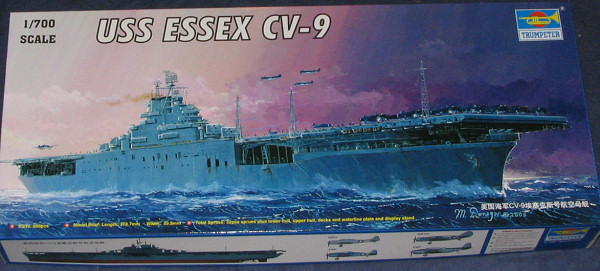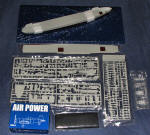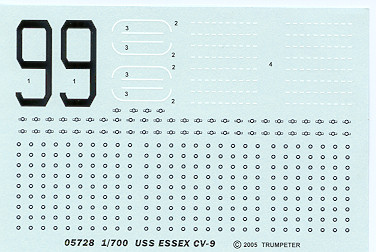|
KIT: |
Trumpeter 1/700 USS Essex |
|
KIT #: |
5728 |
|
PRICE: |
$29.95 MSRP |
|
DECALS: |
One option |
|
REVIEWER: |
Scott Van Aken |
|
NOTES: |
Scaled down from the 1/350 kit |

The fourth Essex (CV-9) was launched 31 July
1942 by Newport News Shipbuilding and Dry Dock Co. sponsored by Mrs. Artemus L.
Gates, wife of the Assistant Secretary of the Navy for Air; and commissioned 31
December 1942, Captain D. B. Duncan command ing. She was reclassified (CVA-9) on
1 October 1952, and (CVS-9) on 8 March 1960.
Following her shakedown cruise Essex sailed to
the Pacific in May 1943 to begin a succession of victories which would bring her
to Tokyo Bay. Departing Pearl Harbor, she participated with Task Force 16 (TF
16) in carrier operations against Marcus Island (31 Aug ust 1943); was
designated flagship of TF 14 and struck Wake Island (5-6 October); launched an
attack with Task Group 50.3 (TG 50.3) against the Gilbert Islands where she also
took part in her first amphibious assault, the landing on Tarawa (18-23
November). Refueling at se a, she cruised as flagship of TG 50.3 to attack
Kwajalein (4 December). Her second amphibious assault delivered in company with
TG 58.2 was against the Marshalls (29 January-2 February 1944).
Essex in TG 68.2 now joined with TG 58.1 and
58.3, to constitute the most formidable carrier striking force to date, in
launching an attack against Truk (17-18 February 1944) during which eight
Japanese ships weresunk. En route to the Marianas to sever Japanese supply
lines, the carrier force was detected and received a prolonged aerial attack
which it repelled in a businesslike manner and then continued with the scheduled
attack upon Saipan, Tinian and Guam (23 February).
After this operation Essex proceeded to San
Francisco for her single wartime overhaul. She then joined carriers USS Wasp
(CV-18) and USS San Jacinto (CVL-30) in TG 12.1 to strike Marcus Island
(19-20 May 1944) and Wake (23 May). She deployed with TF 58 to support the
occupation of the Marianas (12 June-10 August); sortied with TG 38.3 to lead an
attack against the Palau Islands (6-8 September), and Mindanao (9-10 September)
with enemy shipping as the main target, and remained in the area to supp ort
landings on Peleliu. On 2 October 1944, she weathered a typhoon and 4 days later
departed with TF 38 for the Ryukyus.
For the remainder of 1944 she continued her frontline
action, participating in strikes against Okinawa (10 October), and Formosa
(12-14 October), covering the Leyte landings, taking part in the battle for
Leyte Gulf (24-25 October), and continuing the search for enemy fleet units
until 30 October when she returned to Ulithi, Caroline Islands, for
replenishment. She resumed the offensive and delivered attacks on Manila and the
northern Philippine Islands during November. On 25 November, for the first time
in her far-ranging operations and destruction to the enemy, Essex
received injury. A kamikaze hit the port edge of her flight deck landing among
planes gassed for takeoff, causing extensive damage, killing 15, and wounding
44.
This "cramped her style" very little. Following quick
repairs we find her with 3d Fleet off Luzon supporting the occupation of Mindoro
(14-16 December). She rode out the typhoon of 18 December 1944 and made special
search for survivors afterwards. With TG 3 8.3 she participated in the Lingayen
Gulf operations, launched strikes against Formosa, Sakishima, Okinawa, and
Luzon. Entering the South China Sea in search of enemy surface forces, the task
force pounded shipping and conducted strikes on Formosa, the China coast, Hainan,
and Hong Kong. Essex withstood the onslaught of the third typhoon in four
months (20-21 January 1945) before striking again at Formosa, Miyako Shima and
Okinawa (26-27 January).
During the remainder of the war she operated with TF
58, conducting attacks against the Tokyo area (16-17, and 25 February) both to
neutralize the enemy's airpower before the landings on Iwo Jima and to cripple
the aircraft manufacturing industry. She sent support missions against Iwo Jima
and neighboring islands, but from 23 March to 28 May 1945 was employed primarily
to support the conquest of Okinawa.
In the closing days of the war, Essex took part
in the final telling raids against the Japanese home islands (10 July-15 August
1945). Following the surrender, she continued defensive combat air patrols until
3 September when she was ordered to Bremerton, Wash., for inactivation. On 9
January 1947, she was placed out of commission in reserve.
Modernization endowed Essex with a new flight
deck, and a streamlined island superstructure, on 16 January 1951 when
recommissioned, Captain A. W. Wheelock commanding.
After a brief cruise in Hawaiian waters she began the
first of three tours in Far Eastern waters during the Korean war. She served as
flagship for Carrier Division 1 and TF 77. She was the first carrier to launch
F2H Banshee twinjet fighters on combat missions; on 16 September 1951 one
of these planes, damaged in combat, crashed into aircraft parked on the forward
flight deck causing an explosion and fire which killed seven. After repairs at
Yokosuka she returned to frontline action on 3 October to launch strikes up to
the Yalu River and provide close air support for U.N. troops.
On 1 December 1953 she started her final tour of the
war, sailing the China Sea with the Peace Patrol. From November 1954 to June
1955 she engaged in training exercises, operated for three months with the 7th
Fleet, assisted in the Tachen Islands evacuation, and engaged in air operations
and fleet manuevers off Okinawa.
In July 1955 Essex entered Puget Sound Naval
Shipyard for repairs and extensive alterations, including installation of an
angled flight deck. Modernization completed, she rejoined the Pacific Fleet in
March 1956. For the next 14 months the carrier operated off the west coast,
except for a six-months cruise with the 7th Fleet in the Far East. Ordered to
join the Atlantic Fleet for the first time in her long career, she sailed from
San Diego on 21 June 1957, rounded Cape Horn, and arrived in Mayport, Fla., on 1
August.
In the fall of 1957 Essex participated as an
anti-submarine carrier in the NATO exercises, Strike Back, and in
February 1968 deployed with the 6th Fleet until May when she shifted to the
eastern Mediterranean. Alerted to the Middle East crisis on 14 July 1958 she
sped to support the U.S. Peace Force landing in Beirut, Lebanon, launching
reconnaissance and patrol missions until 20 August. Once again she was ordered
to proceed to Asian waters, and transitted the Suez Canal to arrive in the
Taiwan operational area where she joined TF 77 in conducting flight operations
before rounding the Horn and proceeding back to Mayport.
Essex joined with the 2d Fleet and British
ships in Atlantic exercises and with NATO forces in the eastern Mediterranean
during the fall of 1959. In December she aided victims of a disastrous flood at
Frejus, France.
In the spring of 1960 she was converted into an ASW
Support Carrier and was thereafter homeported at Quonset Point, R.I. She
operated as flagship of Carrier Division 18 and Antisubmarine Carrier Group
Three. She conducted rescue and salvage operations off the New Jersey coast for
a downed blimp; cruised with midshipmen, and was deployed on NATO and CENTO
exercises. In November 1960, she joined the French navy in Operation Jet
Stream.
Essex was decommissioned 30 Jun 1969. She was
stricken from the Navy List on 1 Jun 1973, and sold by the Defense Reutilization
and Marketing Service (DRMS) for scrapping 1 Jun 1975.
Essex received the Presidential Unit Citation,
and 13 battle stars for World War II service; four battle stars and the Navy
Unit Commendation for Korean war service.
Historical section blatantly swiped from
http://www.navy.mil/
 Ship
modelers around the world have a lot for which to give thanks. Due to the
efforts of Trumpeter, there are quality models of some very important ships. Of
all the kits they have issued, it has been the aircraft carrier that has
received the greatest attention from modelers. If you think about it, there are
at least a half dozen from pre-WWII to the mid 1990's. And not all of them
are American, as we have seen. However, it is the US carrier that has sold well
and there is no indication of this slowing down any time soon.
Ship
modelers around the world have a lot for which to give thanks. Due to the
efforts of Trumpeter, there are quality models of some very important ships. Of
all the kits they have issued, it has been the aircraft carrier that has
received the greatest attention from modelers. If you think about it, there are
at least a half dozen from pre-WWII to the mid 1990's. And not all of them
are American, as we have seen. However, it is the US carrier that has sold well
and there is no indication of this slowing down any time soon.
The latest is a new tool 1/700 USS Essex that has been
pantographed down from their wildly successful 1/350 kit. I'm so pleased that
Trumpeter has taken this tack with its ships as they are able to satisfy the
needs of two major groups in the ship modeling community.
The kit itself is all that we've come to expect from
Trumpeter in terms of high mold quality, thoughtful engineering and attention to
detail. The info flyer that came with it says there are 606 parts and I can
believe it. In the air wing alone there are nearly 200 spread amongst four types
of aircraft, all in clear plastic. There are SBDs, TBMs, SB2Cs and F6Fs; 12 of
each. Yes, that doesn't come close to the usual air wing of 100 aircraft, but it
is more than enough to look impressive on the deck!
The other 400+ pieces are devoted to ship itself.
Trumpeter provides both full hull and waterline options. A stand is given for
the full hull version and a nice vac sea scape for the waterline. This latter
thing is such a great idea that I'm really surprised no one else has picked up
on it.
The flight deck is in two pieces with separate elevators.
These could be placed in the lowered position, but really, there is nothing to
see aside from a deck for the centerline. All the hangar side doors are
separate, but we will attach them as the hangar deck is devoid of any detail. It
is, however, there so scratch builders will have a great opportunity to have at
it. I'm also surprised that some resin maker hasn't tried to fill this void (pun
fully intended). 
Building the kit will keep one busy for quite some time.
Just assembling the quad 40 and 5 inch AA guns will take some time as there are
a lot of them. Then there are the various bulkheads, sponsons, life boats,
cranes and so on. The island structured is quite complete and has its own array
of AA guns as well. The sound of all those firing off against incoming Japanese
aircraft must have been deafening.
A very nicely done instruction booklet is included and
offers well drawn construction steps. Color information is on a separate,
full-color painting and decaling guide. It is for a Measure 21, 1943 scheme,
which would have been its initial outfitting. I'm not sure how often aircraft
carriers were repainted, but the paint alone must have added several tons. The
decal sheet has insignia for both early and late 1943 aircraft markings and a
simple centerline and ship number marking. It is well printed and I would
recommend some sort of vision enhancement device when putting on those insignia!
This one is bound to be a best seller. There were a number of
Essex class ships launched and used, both in WWII and Korea. I'm only waiting
for the time that a Korean War boxing comes out or even a 27 Charlie angle deck
mod as used in Vietnam. The basics are all there.
If you would like your product reviewed fairly and quickly by a
site that has over 300,000 visitors a month, please
contact
me or see other details in the
Note to
Contributors.
Back to the Main Page
Back to the Previews Index Page


 Ship
modelers around the world have a lot for which to give thanks. Due to the
efforts of Trumpeter, there are quality models of some very important ships. Of
all the kits they have issued, it has been the aircraft carrier that has
received the greatest attention from modelers. If you think about it, there are
at least a half dozen from pre-WWII to the mid 1990's. And not all of them
are American, as we have seen. However, it is the US carrier that has sold well
and there is no indication of this slowing down any time soon.
Ship
modelers around the world have a lot for which to give thanks. Due to the
efforts of Trumpeter, there are quality models of some very important ships. Of
all the kits they have issued, it has been the aircraft carrier that has
received the greatest attention from modelers. If you think about it, there are
at least a half dozen from pre-WWII to the mid 1990's. And not all of them
are American, as we have seen. However, it is the US carrier that has sold well
and there is no indication of this slowing down any time soon. 